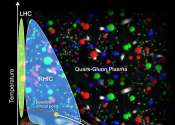Physicists track sequential 'melting' of upsilons
Scientists using the Relativistic Heavy Ion Collider (RHIC) to study some of the hottest matter ever created in a laboratory have published their first data showing how three distinct variations of particles called upsilons ...









